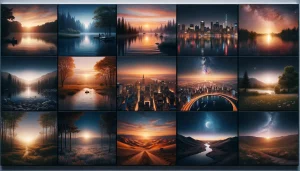Landscape photography is a genre that captivates the imagination, transporting viewers to stunning vistas and serene environments. However, capturing the beauty of a landscape requires more than just pointing your camera at a beautiful scene and clicking the shutter. To create images that truly resonate, mastering the art of composition—particularly the use of angles and framing—is essential. These techniques can transform a simple snapshot into a work of art, guiding the viewer’s eye, enhancing depth, and conveying the grandeur of the natural world.
Understanding Composition Basics
At the heart of great landscape photography lies a solid understanding of composition. Composition is about how elements within a scene are arranged in the frame, and it plays a crucial role in how an image is perceived.
Rule of Thirds: One of the most fundamental composition techniques is the rule of thirds. By dividing the frame into a 3×3 grid, you create four intersections where the lines meet. Placing key elements—such as the horizon, a mountain peak, or a tree—along these lines or at the intersections helps create a balanced and visually appealing image. The rule of thirds encourages a dynamic composition that naturally draws the viewer’s eye across the image, rather than having everything centered, which can sometimes lead to a static or less engaging shot.
Golden Ratio and Golden Spiral: For those looking to advance beyond the rule of thirds, the golden ratio and golden spiral offer more complex, yet highly effective, compositional techniques. The golden ratio, a mathematical ratio commonly found in nature, can be used to arrange elements in a way that feels harmonious and aesthetically pleasing. The golden spiral, which is derived from the golden ratio, guides the viewer’s eye through the image in a natural flow, often leading them to the main focal point. These methods can make an image more dynamic and engaging, offering a subtle but powerful way to enhance your composition.
Utilizing Leading Lines
Leading lines are an essential compositional tool in landscape photography. These are natural lines within the scene—such as rivers, paths, fences, or rows of trees—that guide the viewer’s eye toward the focal point of the image.
Create Visual Flow: The strategic use of leading lines not only enhances depth but also creates a sense of movement within the photograph. For instance, a winding road leading to a distant mountain peak can draw the viewer’s eye into the scene, encouraging them to explore the image further. This technique is particularly effective in creating a visual journey, making the landscape feel more immersive and engaging.
When incorporating leading lines, consider their direction and placement within the frame. Diagonal lines often add dynamism, while horizontal lines can create a sense of tranquility. Vertical lines, such as tall trees or cliffs, can convey power and majesty. By thoughtfully integrating these elements, you can guide the viewer through the landscape, highlighting the most important aspects of the scene

Incorporating Layers
Layering is another powerful technique to add depth and dimension to your landscape photographs. By including elements in the foreground, midground, and background, you create a three-dimensional feel that invites viewers to step into the scene.
Foreground, Midground, Background: When composing a landscape image, consider what elements you can place in each of these planes. For example, a field of wildflowers in the foreground, a river in the midground, and towering mountains in the background can create a rich, layered image. The foreground provides context and scale, the midground connects the viewer with the subject, and the background offers a sense of place and grandeur.
Layering not only adds depth but also helps to tell a story. Each layer can contribute to the overall narrative of the scene, whether it’s the contrast between a tranquil lake and stormy skies or the journey from a sunlit meadow to a shadowy forest. Experimenting with different elements in each layer can lead to a more compelling and nuanced photograph.
Experimenting with Angles and Perspectives
Changing your angle and perspective can dramatically alter the composition and mood of a landscape photograph. While it’s easy to shoot from eye level, exploring different vantage points can reveal new ways to frame the scene.
Change Your Point of View: Getting low to the ground can emphasize textures in the foreground, such as the roughness of rocks or the delicacy of flowers. Alternatively, shooting from a higher vantage point can provide a sweeping view of the landscape, capturing the vastness of the scene.
Consider how different perspectives can influence the viewer’s perception. A low angle looking up at a mountain can make it appear more imposing, while a high angle looking down on a winding river can accentuate its meandering path. By exploring different angles, you can discover unique compositions that might be more compelling than your initial shot.
Looking for Natural Frames
Natural framing involves using elements within the scene—such as trees, archways, or even shadows—to frame the main subject of your photograph. This technique can add depth, context, and focus to your image.
Framing Elements: Look for natural elements that can create a frame within your composition. For instance, overhanging branches can frame a distant mountain, or a rock arch can serve as a window to the landscape beyond. These frames help to direct the viewer’s attention to the focal point of the image, creating a sense of enclosure and focus.
Natural framing also adds context to the scene, providing clues about the environment in which the photograph was taken. It can create a sense of place, making the viewer feel as though they are peering into a hidden or special location. This technique can be particularly effective in landscape photography, where the environment plays a crucial role in the overall composition.
Embracing Symmetry and Balance
Symmetry and balance are key principles in composition that can create a sense of harmony and order in your landscape photographs.
Symmetrical Compositions: Symmetry can be found in many natural scenes, such as reflections in a calm lake, the alignment of trees, or the balance between mountains and valleys. When you encounter symmetry, use it to create a composition that feels balanced and harmonious.
However, perfect symmetry isn’t always necessary. Asymmetrical balance—where different elements on either side of the frame have equal visual weight—can also create a pleasing composition. For example, a large tree on one side of the frame can be balanced by a cluster of smaller trees or rocks on the other side. The key is to achieve a sense of equilibrium that feels natural and visually satisfying.
Simplifying Your Composition
In landscape photography, less is often more. Simplifying your composition by focusing on a few key elements can lead to more striking and impactful images.
Less is More: When composing a shot, ask yourself what the main subject is and whether there are any elements that detract from it. Cluttered scenes with too many competing elements can be overwhelming and distract from the focal point. Instead, aim for a clean and clear composition that directs the viewer’s attention to the most important aspects of the scene.
This doesn’t mean that your images need to be minimalist, but rather that each element should have a purpose in the composition. During shooting, consider moving around to find a less cluttered angle or using a wider aperture to blur out distracting backgrounds. In post-processing, you can further simplify the image by cropping out unnecessary elements or adjusting the contrast and saturation to highlight the key features.
Capturing Scale
One of the challenges in landscape photography is conveying the true scale of the scene. Without a reference point, even the most majestic landscapes can appear flat or underwhelming.
Include Reference Points: To effectively communicate the grandeur of a landscape, incorporate elements that provide a sense of scale. Human figures, animals, or familiar objects like trees or buildings can help viewers appreciate the size and scope of the scene. For example, a tiny person standing at the base of a towering waterfall immediately conveys the height and power of the falls.
Including scale references not only adds context but also creates a connection between the viewer and the landscape. It invites them to imagine themselves in the scene, experiencing the awe and wonder of the natural world.
Working the Scene
One of the most important tips for mastering composition in landscape photography is to take your time and work the scene. Rarely is the first shot the best one—exploring different compositions can lead to unexpected and more compelling results.
Explore Multiple Compositions: When you arrive at a location, resist the urge to start shooting immediately. Instead, take a moment to observe the scene and consider different angles, perspectives, and framing options. Move around, try different focal lengths, and experiment with various compositions.
By working the scene, you allow yourself to see the landscape in new ways. You might discover a unique angle or an interesting element that you initially overlooked. This patience and attention to detail can make the difference between a good photograph and a great one.
Post-Processing Considerations
While composition is largely determined in-camera, post-processing can enhance and refine your final image. Thoughtful editing can help to emphasize the strengths of your composition and bring your vision to life.
Enhance Composition: In post-processing, use tools like cropping to improve the composition if necessary. Adjust the contrast, brightness, and saturation to draw attention to the key elements. For instance, enhancing the contrast can make leading lines more prominent, while increasing saturation can emphasize the rich colors of a sunset.
However, be careful not to over-edit. The goal is to enhance the natural beauty of the scene, not to create an artificial look. Subtle adjustments can often have a more powerful impact than dramatic edits.
Conclusion
Mastering angles and framing in landscape photography is a journey that requires patience, practice, and a keen eye for detail. By understanding composition basics, utilizing leading lines, experimenting with angles, and incorporating layers and frames, you can create images that are not only visually stunning but also emotionally resonant. Remember to take your time, work the scene, and let your creativity guide you.












